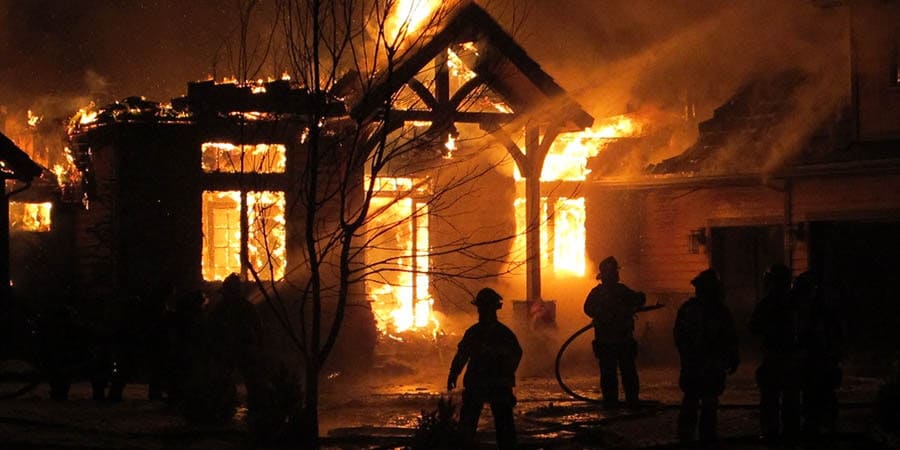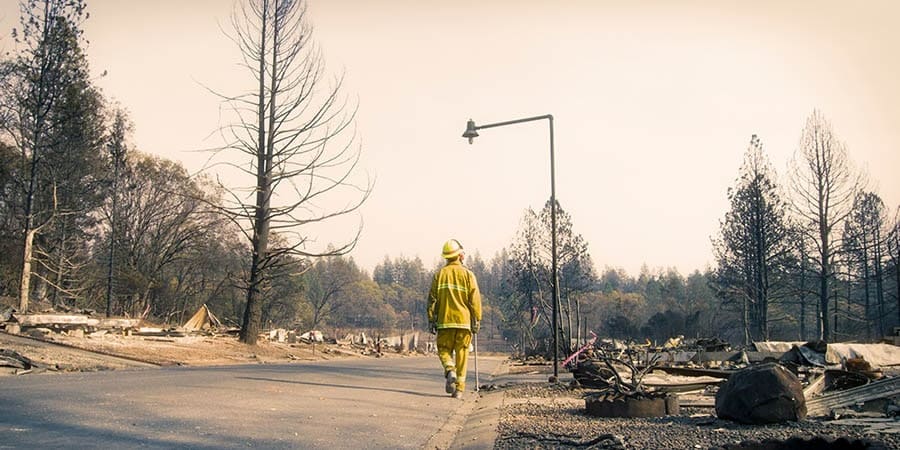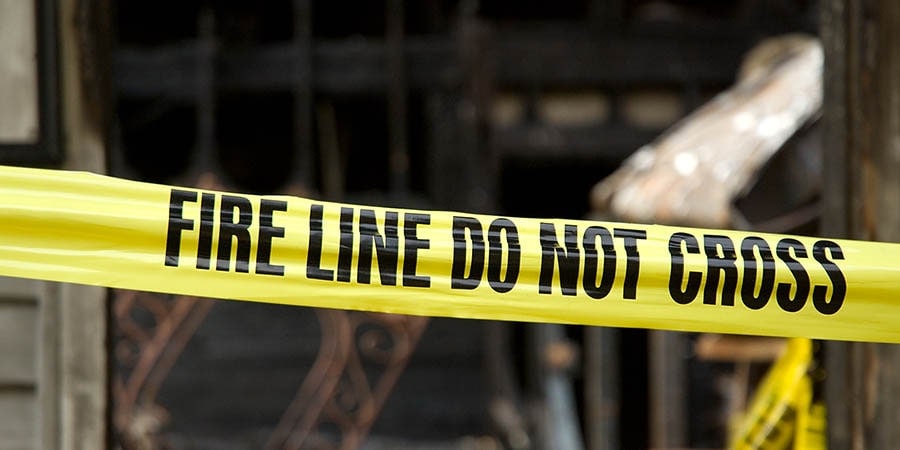A wildland-urban interface (WUI) refers to manufactured structures and undeveloped wildland or vegetation. As they grow, they become increasingly at-risk for wildfires.
Every 23 seconds, a US fire department responds to fire [1].
Over 1/3 of reported fires happened in or on structures. This includes homes that were affected by wildfires [1].
WUI fires caused $4.2 billion in direct property damages in California alone* [1].
States with the most significant potential damage from WUI fires include California, Texas, Florida, North Carolina and Pennsylvania [4].
For the third time in four years, California had a devastating WUI that destroyed more than 2,400 structures, killed 16 people, injured over 100 more, and burned over 300,000 acres [3].
Wildfires can spread up to 14.29 miles per hour once they’ve sparked [5].
*Losses from these fires were not separated into incident types, so this number includes structure fires.
Fire prevention is more important than you may realize. According to the National Interagency Fire Center, 58,950 wildfires occurred in 2020. If you want to avoid being a part of this statistic, practice these general fire prevention practices to help keep your home safe:
Clear your home’s surroundings of debris and combustible materials.
Maintain your lawn and keep bushes and trees trimmed.
Use fire-resistant materials when building or updating your home.
Make sure your home has a fully functioning fire alarm system.
Keep a shovel and fire extinguisher in an easily accessible place.
Practice appropriate fire safety measures with campfires.
Many people think about the safety and security of their families, but they often overlook the dangers posed by fires. In 2020, the National Fire Prevention Agency (NFPA) reported that fires accounted for 12.1 billion dollars in damages to homes and resulted in 3,500 civilian deaths and 15,200 injuries.
Fire safety can make all the difference in fire-prone areas and can help to prevent wildfires from spreading in dry, hot locations. Rather than letting a normal fire get out of hand, keep it contained by arming your home with the appropriate fire protection.


How to protect your house from a wildfire
Western states are particularly prone to the dangers of wildfires. High temperatures and dry conditions are the perfect recipes for spreading the wildfires that sweep across miles and miles of acreage each summer. Over the past twenty years, an annual average of 70,600 wildfires have burned a yearly average of 7 million acres.
Being one of the hottest and driest states, California is no stranger to the dangers of wildfires. In 2020, California was subject to 9,639 fires which burned 4,257,059 acres. And unfortunately, the fire season across California starts earlier and earlier every year.
Drought conditions common in Western states make it even more critical to have fire prevention measures in place. Dry, brittle brush and extreme temperatures can turn a minor mishap into a raging blaze. But remember, these dangerous events are mainly preventable.
According to Cal Fire, 95% of wildfires start from people. Most house fires can be prevented with the proper fire prevention measures. Heed these tips to help avoid home fires before, during and after a wildfire.
What should you do before a wildfire occurs?
You should start by knowing your risk. If you live in an area more prone to wildfires, make sure you purchase the appropriate fire insurance.
For your vehicle, make sure you:
Always maintain vehicles to help avoid sparks. Avoid hanging metal objects underneath your cars, such as loose mufflers or exhaust pipes.
Don’t drag tools or chains from the rear of your car since that could also cause sparks, leading to fires in dry areas.
Keep tires properly inflated and avoid starting vehicles in high, brittle grassy areas.
Contain campfires in fire pits or shallow holes dug in the ground.
Avoid lighting campfires in drought conditions and high winds.
Choose campfire locations that are a safe distance from any fuels or debris that could easily catch fire.
When finished, take extra fire safety precautions to extinguish campfires using water and dirt.
Have fire extinguishers and shovels ready for dousing. Keep these items on hand if conditions elevate more quickly than expected.
An emergency fire preparation kit goes hand-in-hand with a safe evacuation plan. You should have enough food and water for your entire family for at least three days. Have copies of important documents and a radio and headlamp with extra batteries.
Consider adding a spark arrestor on equipment in fire-prone areas. In areas that frequently experience wildfires, spark arrestors are often required on portable tools and other machinery.
Across the United States, increasingly hot and dry conditions make wildfires an issue for many Americans. According to the NIFC, From January to the first week of December 2021, over 54,00 fires were reported across 6.8 million acres.
So what should you do during a wildfire?
If you’re near a wildfire but not in an active evacuation zone, there are a few things that can help reduce your exposure and help stop the spread of wildfire.
First and foremost, you should attempt to minimize exposure to the ash and soot as soon as possible by closing all open windows and doors. Stay inside, if possible, and avoid doing strenuous activities that might make your lungs work harder. Ensure that your air conditioner or any system that circulates air is off.
Ensure that your vehicle has a full tank of gas, and you know alternate safe routes if you need to use public transportation. Have your evacuation plan on hand and learn how to implement it safely.
If you have time, water your shrubs or plants to help reduce damage if the fire gets to your property.
Once an official evacuation happens, you should gather your loved ones and pets and evacuate.
On your way out of the house, turn on interior and exterior lights to make it easier to see in the smoke. Remove flammable items like curtains or gas cans from the garage. If you have outdoor furniture or potted plants in wooden containers, move them away from your home or put them in a safe area away from the potential blaze.
Once you’ve added your emergency kit to your car, make sure that you:
Keep windows and air vents closed as you drive.
Drive slowly and carefully since the smoke will obscure the road.
Tune into a local emergency station for updates as you evacuate.
If you need shelter, the Red Cross offers an interactive map to help you find open shelters.
What should you do after a wildfire?
So your home is cleared and the fire officials are allowing you back into your neighborhood. But what should you do next?
As you drive back to your property, keep an eye out for damages to trees, shrubs and the surrounding landscape. Fire may have burned or loosened branches along the road, so be cautious when driving.
Clear debris along your driveway and remove vegetation burned by the fire so you can clear it once you’ve accessed your home.
Check the property for damage.
Be on the lookout for embers, smoke or sparks in gutters and rooftops.
Check overhanging structures like garden sheds, under decks or in crawl spaces.
Access any potential damage to electrical pumps or other items and check for damages.
If utilities are off, check to see if there’s any damage to the gas lines, meter or propane tank. Don’t try to repair the system or turn on the breaker if you see anything amiss. Wait and call the electrical company.
Be on the lookout for any exposed wires or damaged equipment and immediately report what you find to your utility company.
Look out for anything still smoldering or smoking on your property. Use extreme caution, especially around power lines or poles. Many of these structures may be unstable after a fire.
Now that you’ve secured the outside, it’s time to check the inside of your home.
Be on the lookout for any gas odor during your inspection and immediately retreat if you smell it.
If your power is still on, make sure you turn it off as you check your home. Use a battery-operated flashlight and turn it on before entering since sometimes flashlights produce sparks that may interact with any leaking gas.
Check the attic, basement and every room in the home for any embers.
If you still have power, make sure all electrics are turned off inside before turning the breaker.
Check if the internet or your home security system and alarms are working.
Be cautious about drinking water from the faucet until you get the okay. Water systems are sometimes corrupted during wildfires because of flash floods, so you’ll want to exercise caution.
Throw away food exposed to heat, smoke, flood or soot.
Flash flooding after a wildfire is possible, especially if it rains over a burned area upstream from your residence. Ensure you stay clear of any natural drainage areas like ponds, rivers, or creeks. Keep a radio with you to monitor nearby weather conditions.


Home Fire Protection Tips
In certain areas, small house fires can escalate to wildfires. These could become responsible for millions in damage and thousands of charred acres. Even when fires are primarily confined to wildland, homes can be swept up and swallowed in a matter of seconds.
California and other hot, dry states know that fire safety methods are necessary to keep wildfires under control. The dangers are so prevalent that organizations such as Calfire are devoted to educating the public about proper fire prevention methods and safety during wildfires.
With a few precautions, you can seriously reduce the risk to your family and home.
Protecting your home from house fires
You can take a few precautions to safeguard your home from potential fire hazards. Practicing these fire safety strategies will reduce your likelihood of having to clean up after a fire.
Keep your home clear of any outlying debris: Dispose of any combustible trash that surrounds your home. Clear away anything that could cause a house fire.
Regularly prune your landscaping. Remove dead branches, clean your gutters, and even consider upgrading your plants to more fire-resistant ones like hedging roses, rockrose or aloe. In addition, keep low-hanging foliage trimmed and a safe distance from the outer reaches of your home.
Cover all openings with wire mesh: This fire prevention method keeps any blowing embers from entering your home and catching fire.
Safeguard your roof with fire-resistant materials: House fires are frequently started by blowing embers alighting on rooftops. FEMA recommends that homes in fire-prone areas take precautions by replacing roofing using fire-resistant materials. In addition, keep your gutters clean of all debris.
Store any combustible materials away from your home: Grills make for a great cookout but are not wise to have close to your home when a fire is likely to occur.
Install a fire extinguisher in your home: When all else fails, and a house fire does catch, having a fire extinguisher on hand can help you prevent the damage from spreading.
If you want to go the extra mile, check out these hidden fire hazards in your home.


Fire prevention strategies for your family
In addition to arming your home, you can employ a few fire safety strategies to help keep your family protected.
Keep an outdoor water supply with easy access for firefighters: Leave plenty of room for fire trucks to enter and attach to a water supply, if necessary.
Prepare an emergency evacuation plan with your family: Make sure all family members know what to do and where to go if a house fire occurs. Include an alternate meeting location if your home becomes inaccessible.
What is the best way to get to your car in the event of a fire? Do your children know who they should stay with if an evacuation occurs and they can’t reach you? What should you do with your pets? You should also determine a safe route where a wildfire can happen: not just at home but also at work and school.
Assemble an emergency kit: Emergency kits can make a world of difference if you have to evacuate your home. Make sure to include first aid items, bottled water, food, identification information, any necessary prescriptions, additional clothing, a flashlight (don’t forget extra batteries), and a spare credit card or money.
If a wildfire is imminent, make arrangements for an overnight stay in a safe area: If a wildfire is truly spreading to your home, you may have to stay away for several days. Make provisions in your fire safety plan for an overnight stay for you and your family. Don’t forget about your pets!
Download the Calfire Ready for Wildfires app: The app sends you push notifications of impending fires, provides checklists to help prepare your home and family, offers maps that show current fires, reports stats and information related to current wildfire events, and even supplies a series of education videos for wildfire readiness.
Protect yourself and your family from wildfire smoke: Even if you have evacuated the immediate area of a wildfire, your family could still be harmed by the smoke generated by wildfires. Avoid inhaling smoke when possible. The CDC offers tips to protect yourself from harmful smoke.
In the event of a house fire, your greatest asset is to be prepared. Use these fire safety tips to help you prevent fires and keep your family protected.
Frequently Asked Questions about House Fires
1. What is the main cause of house fires?
According to the NFPA, these are the top 5 causes of home fires: cooking, heating equipment, electrical distribution and lighting equipment, intentional fires and smoking.
What are the chances of your house catching fire?
The NFPA reports that a fire department responds to a fire every 23 seconds. However, smoke detectors may reduce the risk of dying from fire by as much as 55%.
Where do most fires start in homes?
2/3 of home fire deaths and injuries in 2020 were caused by fires that originated in the living room, bedroom or kitchen.
How fast can a house catch fire?
Wildfires can occur quickly, consuming acres and acres of land in just a few minutes. So it stands to reason that homes can also catch fire quickly. Due to the nature of recent upholstery manufacturing, homes are catching fire even more rapidly than they used to. Thirty years ago, you had almost 20 minutes to escape your home, but now that’s down to only three or four minutes.
What are some common causes of wildfires?
Common causes of wildfires include campfires, discarding lit cigarettes, improperly handling matches or fireworks, purposefully burning debris and sometimes arson.
[1] https://www.nfpa.org//-/media/Files/News-and-Research/Fire-statistics-and-reports/US-Fire-Problem/osFireLoss.pdf
[2] https://www.nfpa.org/News-and-Research/Data-research-and-tools/Building-and-Life-Safety/Home-Structure-Fires
[3] https://www.nfpa.org/~/media/Files/News%20and%20Research/Fire%20statistics%20and%20reports/US%20Fire%20Problem/oscatastrophic.pdf
[4] https://www.usfa.fema.gov/wui/what-is-the-wui.html
[5] https://science.howstuffworks.com/nature/natural-disasters/wildfire.html
Related Articles:


